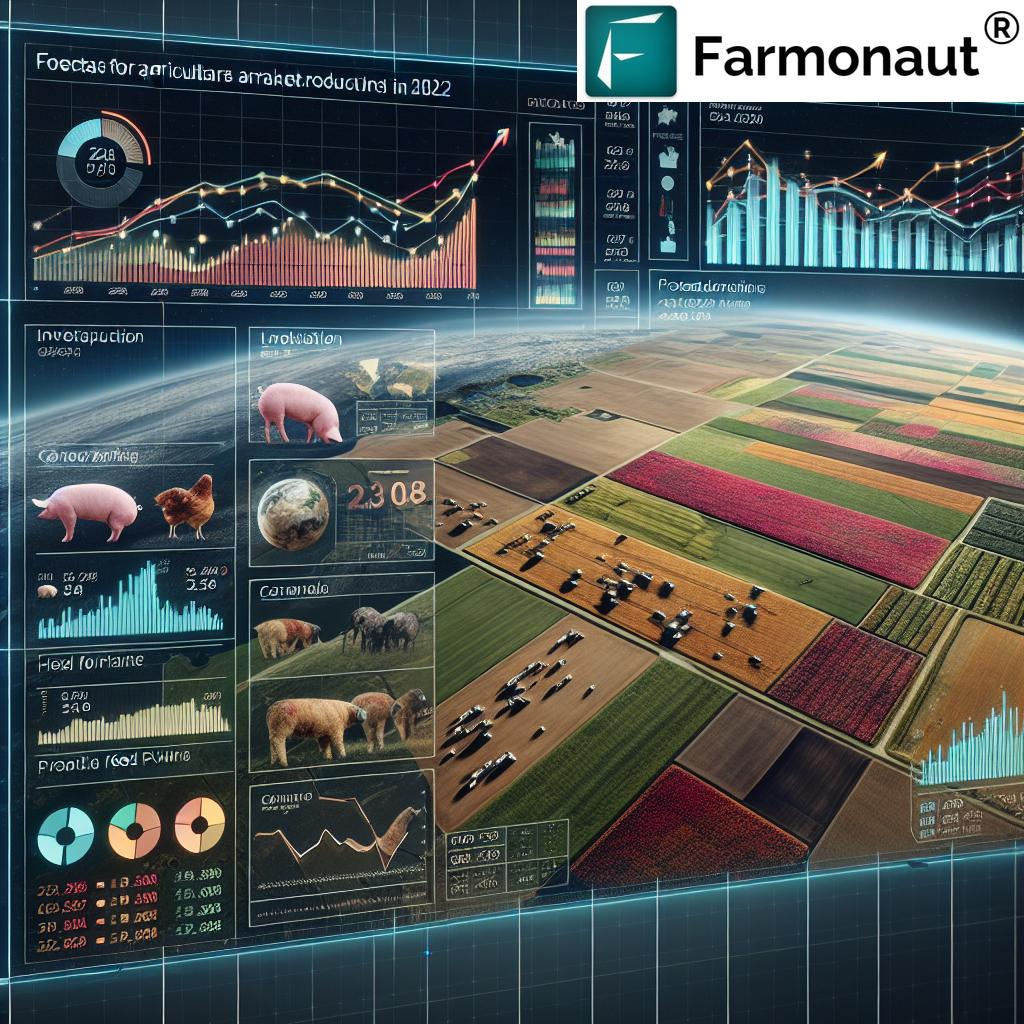Farmonaut’s 2022 Canadian Agricultural Outlook: Navigating Market Trends with Precision Farming Technology
“In 2022, Canadian agricultural output showed a slight decline, impacting market trends and livestock production forecasts.”
As we delve into the 2022 Canadian agricultural market trends and livestock production forecast, we find ourselves at the crossroads of innovation and tradition. The agricultural sector faces unique challenges and opportunities, shaped by global economic factors and technological advancements. In this comprehensive analysis, we’ll explore the key trends emerging in the industry and how precision agriculture technology, like that offered by Farmonaut, can help farmers navigate these complex waters.
Three Key Trends Shaping Canadian Agriculture in 2022
Our research has identified three primary trends that are expected to significantly impact the Canadian agricultural landscape in 2022:
- China’s livestock sector recovery
- Feed cost dynamics
- Evolving demand patterns
Let’s examine each of these trends in detail and consider their implications for Canadian farmers and agribusinesses.
1. China’s Livestock Sector Recovery
The recovery of China’s livestock sector is a crucial factor influencing global agricultural markets. After the devastating impact of African Swine Fever (ASF) in 2018-2019, China has been making significant efforts to rebuild its hog herd. This recovery has far-reaching implications for feed grain demand and global meat trade patterns.
As China’s domestic pork production increases, we anticipate:
- Reduced demand for pork imports
- Increased demand for feed grains and oilseeds
- Potential shifts in global trade flows
For Canadian producers, this trend underscores the importance of staying informed about international market dynamics and being prepared to adapt to changing export opportunities.
2. Feed Cost Dynamics
Feed costs remain a critical factor in livestock production profitability. While we’ve seen some easing in feed prices compared to the highs of 2021, costs are still elevated compared to historical averages. This trend is likely to continue impacting producer margins in 2022.
Key factors influencing feed costs include:
- Global grain and oilseed production levels
- Weather conditions in major producing regions
- Transportation and logistics challenges
- Demand from China and other major importers
To navigate this challenging cost environment, producers may need to explore alternative feed sources, optimize feed efficiency, and leverage precision agriculture technologies to maximize crop yields.
3. Evolving Demand Patterns
Consumer preferences and buying habits continue to evolve, influenced by factors such as health concerns, environmental awareness, and economic conditions. In 2022, we expect to see:
- Continued growth in demand for plant-based protein alternatives
- Increased consumer interest in locally sourced and sustainable products
- Shifts in purchasing patterns due to inflationary pressures
These evolving demand patterns present both challenges and opportunities for Canadian agricultural producers. Adapting to changing consumer preferences may require adjustments in production practices, marketing strategies, and potentially even crop or livestock choices.

2022 Production Outlook and Statistics
As we examine the production statistics for 2022, we observe a slight decline in Canadian agricultural output compared to the previous year. This decline can be attributed to various factors, including weather conditions, input costs, and global market dynamics.
Here’s a breakdown of key production statistics:
- Grain and oilseed production: Expected to decline by 2-3% due to drought conditions in some regions
- Livestock production: Forecast to remain relatively stable, with a slight increase in poultry and a marginal decrease in hog production
- Dairy production: Projected to grow by 1-2%, driven by domestic demand
It’s important to note that these are national averages, and regional variations may be significant. Producers should consider local conditions and market dynamics when making production decisions.
Market Forecast: Mixed Margins for Producers
Our analysis suggests that 2022 will bring mixed margins for Canadian agricultural producers. While prices for many agricultural products are expected to rise year-over-year, increased input costs may offset these gains for some producers.
Factors influencing producer margins include:
- Higher fertilizer and fuel costs
- Increased labor expenses
- Supply chain disruptions affecting input availability and prices
- Potential for higher interest rates impacting financing costs
To navigate these challenges, producers may need to focus on efficiency improvements, cost management strategies, and potentially explore value-added opportunities to enhance profitability.
Domestic Consumption: Signs of Recovery
Despite ongoing inflationary pressures and supply chain issues, we’re seeing signs of recovery in domestic consumption of agricultural products. This trend is driven by several factors:
- Gradual easing of pandemic-related restrictions
- Pent-up consumer demand
- Increased interest in home cooking and local food sourcing
However, it’s important to note that inflationary pressures may impact consumer purchasing power and potentially shift demand towards lower-priced alternatives in some product categories.
Navigating Challenges with Precision Agriculture Technology
As the agricultural landscape becomes increasingly complex, precision agriculture technology offers powerful tools to help farmers navigate these challenges. Farmonaut’s satellite-based farm management solutions provide valuable insights that can help optimize production, reduce costs, and improve sustainability.
Key benefits of precision agriculture technology include:
- Real-time crop health monitoring
- Optimized resource management
- Data-driven decision making
- Improved yield forecasting
By leveraging these technologies, Canadian farmers can enhance their resilience to market fluctuations and environmental challenges.
Explore Farmonaut’s precision agriculture solutions:
For developers interested in integrating Farmonaut’s technology:
Sustainable Farming Practices: A Key to Long-Term Success
As environmental concerns continue to shape consumer preferences and regulatory landscapes, sustainable farming practices are becoming increasingly important. Adopting these practices can help Canadian farmers:
- Reduce environmental impact
- Improve soil health and productivity
- Enhance resilience to climate variability
- Meet evolving consumer and regulatory demands
Farmonaut’s precision agriculture technology can play a crucial role in implementing and optimizing sustainable farming practices. By providing detailed insights into crop health, soil conditions, and resource usage, our platform enables farmers to make informed decisions that balance productivity with environmental stewardship.
“Despite economic challenges, agricultural product prices were expected to rise year-over-year in 2022, affecting producer margins.”
The Role of Satellite Crop Monitoring in Modern Agriculture
Satellite crop monitoring is revolutionizing the way farmers manage their operations. This technology offers several key advantages:
- Large-scale coverage: Monitor vast areas efficiently
- Frequent updates: Track crop development throughout the growing season
- Non-invasive: Gather data without disturbing crops or soil
- Multi-spectral analysis: Detect issues invisible to the naked eye
Farmonaut’s satellite crop monitoring service provides Canadian farmers with actionable insights to optimize their operations and respond quickly to emerging issues.
Optimizing Farm Management with Data-Driven Insights
In the face of complex market trends and production challenges, data-driven farm management is becoming essential. Farmonaut’s farm management software offers a comprehensive suite of tools to help Canadian farmers make informed decisions:
- Real-time crop health monitoring
- Weather forecasting and alerts
- Soil moisture analysis
- Yield prediction models
- Resource optimization recommendations
By leveraging these tools, farmers can improve efficiency, reduce waste, and maximize profitability in the face of changing market conditions.
Experience the power of data-driven farm management:
Agricultural Supply Chain Optimization
Supply chain disruptions have been a significant challenge for the agricultural sector in recent years. Optimizing supply chains can help mitigate these issues and improve overall efficiency. Key strategies include:
- Diversifying suppliers and transportation options
- Implementing real-time tracking and inventory management systems
- Exploring local and regional sourcing opportunities
- Leveraging data analytics to forecast demand and optimize logistics
Farmonaut’s technology can contribute to supply chain optimization by providing accurate yield forecasts and production data, enabling better planning and coordination across the supply chain.

2022 Canadian Agricultural Market Trends Comparison
| Trend | 2021 Status | 2022 Forecast |
|---|---|---|
| China’s Livestock Sector Recovery | Ongoing | Accelerating |
| Feed Costs | Very High | High, Slight Easing |
| Demand Patterns | Volatile | Evolving |
| Overall Producer Margins | Squeezed | Mixed |
| Canadian Agricultural Output | Stable | Slight Decline |
| Domestic Consumption | Recovering | Continued Recovery |
Leveraging Technology for Agricultural Economics
Understanding and applying agricultural economics principles is crucial for farm profitability. Farmonaut’s technology can provide valuable data and insights to support economic decision-making:
- Yield forecasting for better production planning
- Resource optimization to reduce input costs
- Market trend analysis for informed crop selection
- Risk assessment tools for financial planning
By integrating economic principles with real-time data and advanced analytics, Canadian farmers can make more informed decisions and improve their overall financial performance.
Adapting to Changing Market Conditions
The ability to adapt quickly to changing market conditions is crucial for success in today’s agricultural landscape. Farmonaut’s precision agriculture technology provides farmers with the tools they need to remain agile and responsive:
- Real-time market data integration
- Scenario planning tools
- Rapid crop health assessments
- Flexible resource allocation recommendations
By leveraging these capabilities, Canadian farmers can position themselves to take advantage of emerging opportunities and mitigate potential risks in a dynamic market environment.
The Future of Canadian Agriculture: Embracing Innovation
As we look beyond 2022, it’s clear that innovation will play a crucial role in shaping the future of Canadian agriculture. By embracing precision farming technologies, sustainable practices, and data-driven decision-making, Canadian farmers can enhance their resilience, productivity, and profitability.
Farmonaut is committed to supporting this journey of innovation, providing cutting-edge tools and insights to help Canadian farmers thrive in an ever-changing agricultural landscape.
Conclusion
The 2022 Canadian agricultural outlook presents a complex landscape of challenges and opportunities. While factors such as China’s livestock sector recovery, feed cost dynamics, and evolving demand patterns create uncertainties, they also open doors for innovation and adaptation.
By leveraging precision agriculture technologies like those offered by Farmonaut, Canadian farmers can navigate these challenges more effectively. Real-time crop monitoring, data-driven insights, and advanced analytics provide the tools needed to optimize production, manage costs, and respond swiftly to market changes.
As we move forward, the integration of sustainable practices, technological innovation, and economic savvy will be key to the continued success and resilience of Canadian agriculture. Farmonaut stands ready to support Canadian farmers on this journey, providing the cutting-edge solutions needed to thrive in an ever-evolving agricultural landscape.
FAQ Section
Q: How can precision agriculture technology help Canadian farmers in 2022?
A: Precision agriculture technology, such as Farmonaut’s satellite-based solutions, can help Canadian farmers optimize resource use, monitor crop health in real-time, make data-driven decisions, and adapt quickly to changing market conditions.
Q: What are the main challenges facing Canadian agriculture in 2022?
A: Key challenges include navigating the impact of China’s livestock sector recovery, managing high feed costs, adapting to evolving demand patterns, and maintaining profitability in the face of rising input costs.
Q: How can farmers use satellite crop monitoring to improve their operations?
A: Satellite crop monitoring provides large-scale, frequent, and non-invasive data collection. Farmers can use this information to detect crop health issues early, optimize resource allocation, and make informed management decisions.
Q: What role does sustainable farming play in the 2022 agricultural outlook?
A: Sustainable farming practices are increasingly important due to environmental concerns and changing consumer preferences. They can help farmers reduce environmental impact, improve soil health, enhance resilience to climate variability, and meet evolving market demands.
Q: How can Canadian farmers optimize their supply chains in 2022?
A: Farmers can optimize supply chains by diversifying suppliers, implementing real-time tracking systems, exploring local sourcing options, and using data analytics for demand forecasting and logistics optimization.
Farmonaut Subscriptions






